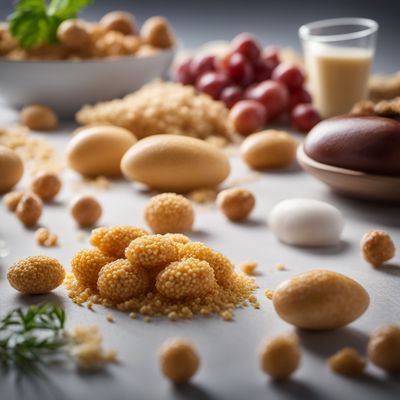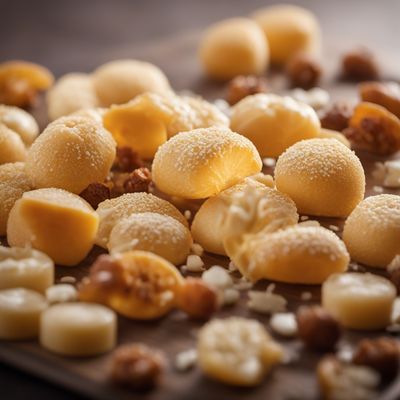
Ingredient
Antioxidant
"Nature's Defense: Unleashing the Power of Antioxidants"
Antioxidants are natural substances that help protect our cells from damage caused by harmful molecules called free radicals. They are known for their ability to neutralize these free radicals, preventing oxidative stress and reducing the risk of chronic diseases. Antioxidants can be found in a wide range of fruits, vegetables, nuts, seeds, and even some beverages like green tea and red wine. They come in different forms, including vitamins (such as vitamins C and E), minerals (such as selenium and zinc), and phytochemicals (such as flavonoids and carotenoids). These compounds give antioxidants their vibrant colors and contribute to their health-promoting properties. Incorporating antioxidant-rich foods into our diet is essential for maintaining optimal health and preventing various diseases.
Origins and history
The concept of antioxidants dates back to the early 20th century when researchers discovered the role of vitamin C in preventing scurvy. Since then, extensive research has been conducted to explore the benefits of antioxidants in human health. Many traditional cultures have long recognized the importance of antioxidant-rich foods in their diets. For example, ancient civilizations like the Egyptians and Greeks used herbs and spices with high antioxidant content for medicinal purposes. Over time, scientific advancements have shed light on the mechanisms and benefits of antioxidants, leading to their widespread recognition and incorporation into modern diets.
Nutritional information
Antioxidants provide essential nutrients and play a vital role in maintaining good health. They help protect cells from damage, support the immune system, and reduce the risk of chronic diseases. Antioxidant-rich foods are typically low in calories and high in vitamins, minerals, and fiber, making them an excellent addition to a balanced diet.
Allergens
Antioxidants themselves are not known allergens. However, some foods rich in antioxidants, such as nuts, seeds, and certain fruits, may trigger allergies in susceptible individuals. It is important to be aware of any known allergies and consult with a healthcare professional if necessary.
How to select
When selecting antioxidant-rich foods, look for fresh produce that is vibrant in color and free from blemishes or signs of decay. Choose organic options whenever possible to minimize exposure to pesticides. For packaged antioxidant supplements, opt for reputable brands that undergo rigorous quality testing.
Storage recommendations
To preserve the antioxidant content of fresh produce, store them properly. Most fruits and vegetables should be stored in the refrigerator, while herbs and spices can be kept in a cool, dry place away from direct sunlight. It is best to consume antioxidant-rich foods as soon as possible after purchase or harvest to maximize their nutritional benefits.
How to produce
Antioxidants are naturally produced by plants as a defense mechanism against environmental stressors. To grow antioxidant-rich foods, consider cultivating a variety of fruits, vegetables, herbs, and spices in your garden or even in pots on a balcony or windowsill. Research specific plant varieties known for their high antioxidant content and follow proper cultivation practices.
Preparation tips
To retain the maximum antioxidant content, it is advisable to consume antioxidant-rich foods in their raw or lightly cooked form. Overcooking or prolonged exposure to heat can lead to nutrient loss. Incorporate antioxidant-rich ingredients into salads, smoothies, stir-fries, or enjoy them as a snack. Pairing foods high in vitamin C with iron-rich foods can enhance iron absorption due to the antioxidant properties of vitamin C.
Culinary uses
Antioxidant-rich ingredients are widely used in various culinary applications. Berries, such as blueberries and strawberries, are often used in desserts, smoothies, and breakfast dishes. Dark leafy greens like spinach and kale can be incorporated into salads, soups, and sautés. Herbs and spices like turmeric, cinnamon, and oregano add flavor and antioxidants to savory dishes. Green tea and red wine are popular beverages known for their antioxidant content.
Availability
Antioxidant-rich foods are commonly available in most regions and countries. However, the specific varieties and seasonal availability may vary. It is best to consult local farmers' markets, supermarkets, or specialty stores to find a wide range of antioxidant-rich ingredients.
More ingredients from this category » Browse all

Anti-foaming agent
The Silent Hero: Taming the Bubbles in Your Culinary Creations

Propellent gas
The Power Behind the Spray: Unveiling the Secrets of Propellent Gas

Gelling agent
The Magic of Gelling Agents

Preservative
Preserving the Goodness: Unveiling the World of Food Preservatives

Binding agent
The Glue of Culinary Creations: Unveiling the Power of Binding Agents

Flavour enhancer
The Magic of Umami

Glazing agent
Enhancing Food Appeal

Modified starch
The Versatile Transformations of Starch

Emulsifying salts
The Magic of Emulsifying Salts

Anti-caking agent
The Secret Ingredient: Unveiling the Magic of Anti-Caking Agents

Emulsifier
The Harmony Enhancer

Flour treatment agent
The Secret Ingredient for Perfect Baked Goods